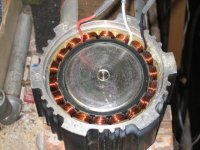I've been using up my profanity usage on my electric motorcycle build. From the machine shop getting my motor mount wrong 3 times, to a company selling me non-standard #41 chain and refusing to refund my money even after I proved to them the chain was incorrect. To top it off, as I'm doing the assembly today I realized that I got too rambunctious with the grinder when I took it apart and inadvertently cut load bearing parts of the frame that I shouldn't have cut. It's been a steady stream of stress relieving language.
In the meantime, back to topic, regarding my nemesis, things electronic, I've just been waiting for you guys to sort it out. I did manage to open one up and reverse the rotation successfully on the first attempt, so I have some degree of confidence that wiring it with the Ecrazy controller will go smoothly. Of course I may be deluding myself, but since I have 3, I will have my sledgehammer handy. I consider my time to be more valuable than one of these motors, so if the frustration builds I will sentence the motor to a swift and sure execution.
Just for the record, my money is still on Blue-Green-Yellow for both hall and phase sequence, in the direction that you want the motor to spin. Let's just hope we all have the same motor and controller wiring or we're in for additional language fresh from the gutter.
John



